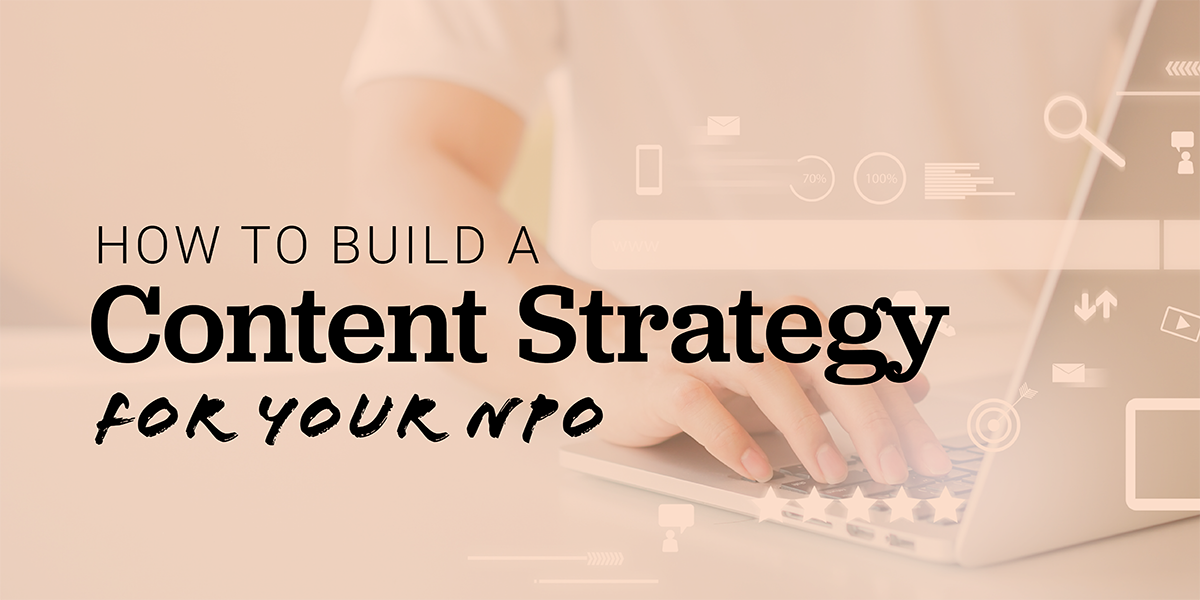How to Build a Content Strategy for Your NPO
Ilia Jones | April 2021

Whether your nonprofit organization is new to content marketing or wants to revamp its content strategy, we’ve broken it down to the basics.
What is a content strategy?
A content strategy is really just the plan for how your nonprofit organization communicates with your target audience. The key word here is “plan.” As in, if you don’t have a plan, your blogs, social media, and email campaigns can come across as scattershot and spammy.
When you have a strategy behind developing and sharing content with your target audience, you can create valuable content that connects, inspires, and educates.
Why is a content strategy important?
A content strategy is vital for nonprofits because your marketing dollars stretch further when your efforts are organized around a goal. It should be part of your overarching digital marketing strategy.
Creating original content is time-consuming and expensive. So a content strategy puts every piece of your content to work toward the goal of educating, inspiring, and ultimately driving donations and support for your organization and cause.
What can a content strategy do for your nonprofit?
A well thought out content strategy can help your nonprofit organization:
- Align all shared content around your mission, vision, and values
- Build credibility and trustworthiness with content that shares what you do and why
- Gain visibility and stand out by identifying what makes you unique
- Support your overall marketing goals, drive donations and increase support and community
A content strategy requires you to carefully consider the content you’re creating and sharing. That way, you can make sure it aligns with who you are and what you are trying to achieve.

Step 1: Set Goals for Your Content Strategy
The first step to creating a successful content strategy is to define what success looks like for your nonprofit.
Identify the platforms you’ll use
Of course, include your website, email campaigns, and other owned properties in your strategy. But you will also want to document any social media that you’re actively using. Facebook, Instagram, Twitter are all great ways to gain traction with your target audience. However, if you’re not using a platform frequently or have no interest in pursuing a following where it’s just not working, leave them out. Why spin your wheels? Instead, focus on where you’re most likely to see success.
Define Your Key Performance Indicators (KPIs)
Determine what you need to measure to determine whether your strategy is successful or not. This may be tracking social media interactions, growing your email list, counting visitors on your website, or adding newsletter subscribers. These KPIs will be unique to your organization and should illustrate the overall goal you’re trying to achieve.
Capture Your Baseline Metrics
You can’t succeed if you don’t know where you started. Once you’ve defined your KPIs, then take a baseline measure before putting your content strategy in place. This should clearly describe your starting point so you can track every improvement from now on. Avoid the urge to redefine your baseline too soon after implementing your new strategy, as it will skew your results. You will never succeed if you keep moving the goalposts!
Set clear objectives
Now that you know where you’re starting from and what you’re measuring, what does success look like? Is it organically gaining 1000 new followers on Instagram? Or increasing web traffic by 200%?
Set clearly defined goals based on your KPIs and measure your progress periodically. That’s really all there is to it.
Step 2: Know Who You Are and How to Speak From the Heart
The next step in creating your content strategy is to closely examine how your nonprofit organization communicates. You need to determine how to authentically share with your community and put guidelines in place to achieve the right tone in all of your communications. You need to define your mission.
Figure out your “Why”
Your nonprofit organization was created for a reason, so tell the story. Take a close look at why you exist, who you exist to serve and what problems you hope to solve. All communications should be created from the foundation of your values.
Explain your “How”
Now that you’ve discovered your “why,” it’s time to take a close look at your “how.” Put simply, what do you do? How are you solving problems? What is your approach to effecting change? Break it down into simple, bite-sized pieces. You create valuable, educational content when you explain how your approach is unique and different from others in the field.
Create messaging guidelines
Once you know your “why” and “how,” it’s time to define how best to incorporate that into everything you say. Language is subjective. There are a thousand different combinations of words to describe something as simple as an apple. So, take time to craft key messages, phrases and ways to explain what you do and why you do it. Also, describe the population or cause you serve, the community you are a part of, or hope to build.
It might seem dull or uncreative to use the same verbiage to describe what you do. But steady tone means you’re communicating a consistent message.

Step 3: Prioritize the Information That Fits Your Mission
As you get started with your new content strategy, it can seem daunting to create a slew of new content. And that’s certainly part of it. But what you have already is probably valuable. It just needs a minor tweak. This is where prioritization comes in.
Perform a content audit
Before you start creating everything from scratch, review what you already have. If your organization isn’t brand new, you probably have blog posts, web content, and other material that fits your goals. But you’ll never know if you don’t take stock of what is already published.
Optimize existing content
Once you’ve identified content that meets your goals, figure out what you can do to optimize it. This can be low-hanging fruit with a big payoff if you do it right. For example, you can update existing blog posts with new SEO keywords and re-publish them. Find a few ways to fix up what you already have for “new” material.
Create a plan for creating new content
While upcycling old copy is great, you will also have to create new content from scratch. Brainstorm a list of blog topics, look at your social media calendar and upcoming events and see what ideas come up. Just remember to focus on providing valuable content that fits your strategy and speaks to your mission.
Step 4: Document Your Content Strategy Clearly
You’ve done the work, and you’re ready to put it into action, but first, you need to document it. After all, it’s not really a plan if it hasn’t been written down and communicated across your marketing team.
Track your efforts
As you’re getting ready to put your plan into action, determine who will track your progress and how frequently. Checking your social media stats and website traffic daily can be a waste of time and energy. So, develop a cadence of how often progress should be tracked that makes sense for your team. You will also need to determine how to communicate your progress with the team and your leadership.
Tweak Your Strategy as needed
Over time, as you start to see progress, you may need to tweak your plan to focus on areas where you are succeeding or where you may not be doing as well. Just don’t be too hasty to throw in the towel or start from scratch. It can take some time to see the payoff of all your hard work.
Now, Get Started!
If you’ve followed the steps and have your content strategy ready to go, the only thing left to do is roll up your sleeves and get to work.
At ArcStone, we know content marketing can seem overwhelming, confusing, or even impossible to achieve on a nonprofit budget. But it is an essential part of getting the message and mission of your organization out into the world. After all, if you aren’t connecting with your donor audience, you’re missing out on the community, and they’re missing out on being able to support your cause.
If you need more marketing help, check out our blog for many nonprofit-specific tips. Or contact us if you’d like to learn more about the digital marketing services we offer nonprofit organizations.
